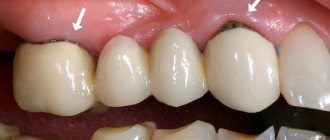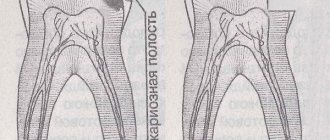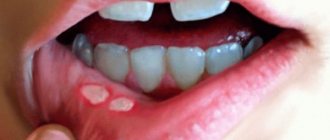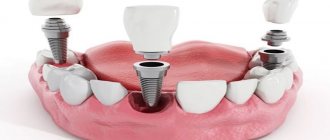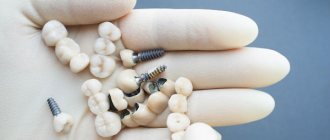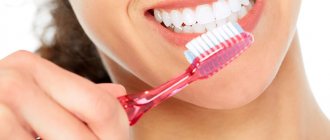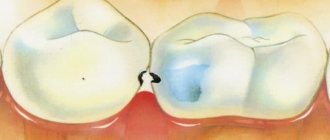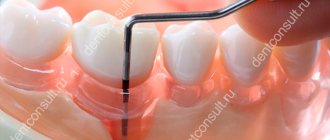Signs of a problem
After prosthetics, it is necessary to carefully monitor the condition of the prepared area. The following symptoms indicate the occurrence of putrefactive processes:
- bad breath that does not go away after brushing your teeth, using mint chewing gum and mouthwash;
- black dentin under the crown;
- pain in the area of the ground tooth;
- food gets stuck between the crown and the tooth; you can feel the hole in the structure with your tongue;
- swelling of the gums and muscle tissue of the cheeks.
The appearance of the smell and taste of blood in the mouth may be associated with the development of gingivitis - inflammation of the gums around the crown. The contact of an incorrectly installed prosthesis with soft tissues leads to irritation and injury. If an infection occurs, pus may leak from the wounds.
Due to the loose fit of the gums, food debris will fall into the gap. Poor oral hygiene causes odor and gum inflammation
Sometimes there is no smell of rot, but for some reason a specific taste is felt in the mouth from the crown. This often indicates incomplete release of cement from the base. Because of this, it gradually dissolves in saliva. An unusual taste may also arise if the materials used for the production of crowns and fillings are incompatible. The solution is to replace the insert structure.
Some patients may have an allergic reaction to plastic. In this case, it is recommended to use metal-ceramic products or ceramics, which are not only hypoallergenic, but also have good aesthetic qualities.
Common causes of unpleasant odor
How to fix the problem?
Only a specialized dentist can accurately determine the cause of food retention and eliminate it!
I think it’s time to start living a comfortable life, enjoying food and not thinking about how and where it will get stuck next time. Don’t waste time, sign up for a consultation and start living in peace. The main treatment is to form the correct contact point (the point of contact between the lateral teeth). Caries is cured using modern filling materials and matrix systems. It is very important that the filling has the correct shape and there is tight contact at the point of contact with the adjacent tooth (dental floss passes through interdental contact with resistance and a click).
If the problem of food getting stuck between the teeth is the overhanging edge of the filling or its irregular shape, then the filling is replaced with a new one. Dental prosthetics are required when there are unsatisfactory dentures and crowns, which also need to be replaced. Food does not get stuck only when there is a complete removable denture. But when partial removable dentures are used, the accuracy of the fit of the prosthesis to the adjacent teeth is important.
The presence of deep pockets or “black triangles” can be corrected using surgical treatments.
Diastema, trema and crowding of teeth are corrected with the help of orthodontic treatment or aesthetic restoration of teeth (veneers, fillings, crowns).
Supra- and subgingival tartar can be removed during professional teeth cleaning. Using a special tool, hard dental deposits are removed by polishing the roots.
Causes of odor and possible complications
In order to eliminate the source of the odor, it is necessary to remove the crown. Most often, complication occurs for the following reasons:
- The gap between the tooth and a poorly made crown, into which pieces of food and sugar dissolved in saliva become clogged. Organic particles decompose, causing tissue to rot, which may darken over time. This occurs when the technology for taking impressions and making a crown is violated.
- Poor quality treatment of a tooth subjected to prosthetics. Because of this, dentin damage begins to progress rapidly.
- Violation of the tightness of the cement connecting the crown and stump of the tooth. Saliva falling on metal elements causes an oxidative reaction.
- While the permanent structure is being manufactured, a temporary crown must be installed. A stump left unprotected can become covered with bacterial plaque and begin to deteriorate.
- Installing a crown on a tooth with pronounced signs of decay. If there is serious damage to the bone tissue, the tooth must be removed and implanted. Otherwise, prosthetics becomes only a temporary measure.
- Neglect of oral care. Good hygiene is important not only to preserve your natural dentition, but also to keep your dentures in good condition. Insufficient cleaning of the chewing surface leads to caries.
If there is a smell from under the crown of a tooth, your dentist will tell you what to do. Lack of therapy and attempts to get rid of the stench on your own significantly aggravate the situation. Rotting of dentin under the crown leads to serious consequences:
- Due to the proliferation of pathogenic bacteria, the risk of developing a cyst, as well as severe inflammation of the gum tissue, increases.
- With the development of secondary caries or pulpitis, teeth can quickly deteriorate and fall out.
- The flux formed in the area of depressurization of the structure does not pass on its own. It must be opened in the dental office, and then treated with antibacterial drugs.
Inside view of a problematic metal prosthesis
What does the smell from under the crown indicate and what to do
Many people ignore the appearance of bad breath.
However, the smell may be a symptom of the development of a dangerous process in the oral cavity. If this unpleasant phenomenon appears from under the crown, you should consult a doctor, because... this indicates tooth decay and can lead to dangerous complications.
The content of the article:
Ways to solve the problem
To eliminate the pathology, the specialist removes the prosthesis and examines it, identifying the cause of the infection. The dentist cleans the dentin and, if possible, carries out treatment. If the damage has affected the deep layers of bone tissue, the tooth is removed and an implant is installed.
In order to increase the likelihood of preserving your dentition, it is important to go to a specialist when the first alarming symptoms appear. If a visit to the doctor has to be postponed for any reason, you should rinse your mouth with decoctions of oak bark, chamomile or calendula. This will temporarily eliminate odor from under the crown, flush out organic debris and pus, and reduce inflammation.
Purulent inflammation is the cause of the odor, requiring an immediate visit to the dentist
For a complete cure, complete therapy is necessary, which is selected depending on the factor that caused the decay:
- If the denture does not fit correctly or becomes loose during wear, the doctor removes the structure and cleans the dentin. After this, a new crown is made to ensure a tight fit and preserve the health of the bone tissue.
- The use of low-quality materials in the production of a prosthesis leads to its weak fixation and destruction of unprotected enamel. To prevent the root from dying, it is necessary to replace the structure with a stronger one.
- In case of pathology caused by a dental error, the doctor must correct the errors in his work. If a tooth under the crown has rotted, re-prosthetics should be done immediately.
- If the cause of inflammation is the crown size being too large, the dentist trims the soft tissue or changes the product to a suitable one.
- If the nerve is preserved in the diseased tooth, after removing the crown, depulpation is performed and a temporary structure is installed. If the patient does not experience discomfort over the next two weeks, a permanent prosthesis is placed.
If there are contraindications to the installation of crowns, they must be eliminated before re-prosthetics. It is unacceptable to install artificial structures in the following cases:
- thinned tooth walls;
- damage to periodontal tissues;
- broken bite causing enamel wear;
- mobility of chewing elements;
- low outer part of the tooth.
Restoration and re-installation of the crown
Consultation with orthopedic dentist S.V. Zukora
A patient, a young man, came to the Family Dentistry with complaints that after a filling was placed on a tooth (in another clinic), food began to get stuck between his teeth. After every meal, he had to floss food stuck in the gap between his teeth, but it felt like the food was not being completely removed. The gums in this area began to hurt.
Orthopedic dentist S.V. Zukor conducted an examination and found out that the problem tooth had been previously treated. In the clinic where the patient was previously treated, the nerve was removed from his tooth, a pin and a large light-curing filling were installed. The filling occupies more than 50% of the tooth volume. The filling is made in such a way that there is a gap between the teeth, that is, tight interdental contact is not created, as it should be, so food gets between the teeth and the gums are injured.
At Dial-Dent, doctors do not recommend restoring a pulpless tooth (a tooth in which the nerve has been removed) with fillings, since a non-vital tooth is more fragile and can break under stress. It is recommended to restore a tooth with a removed nerve with crowns or inlays (depending on the degree of destruction). But before installing a crown or inlay, you need to make sure that the tooth canals are sealed with high quality - tightly and to the full length. If the canals are poorly sealed, inflammation will occur in the tooth under the crown, and the service life of the crown will be shortened, and the tooth can be lost.
To diagnose the condition of the canals in the tooth, an X-ray of the tooth was taken.
An image of the tooth showed that the canal in the tooth was not filled satisfactorily.
Based on the diagnostic results, treatment tactics were planned.
Treatment plan:
- re-treatment of the tooth canal with a microscope, removal of the old pin, dense filling of the canal, installation of a fiberglass pin as the basis for a ceramic crown;
- dental prosthetics with a ceramic crown to restore the shape and function of the tooth.
At Dial-Dent, these stages of treatment will be carried out by different specialists (endodontist and orthopedic dentist), since the narrow specialization of doctors in practice has shown higher effectiveness of treatment, especially when using high-tech methods.
Preventive measures
To avoid repeated tooth decay after eliminating the pathology, you should properly care for your oral cavity. You can carry out complete cleaning using special devices:
- A tuft brush specially designed for the care of implants, bridges, dentures and braces.
- An interproximal brush is a brush that can be used to clean hard-to-reach blackened areas without using paste.
- Dental floss - frees the interdental space from foreign particles, not recommended for inflamed gums. It is advisable to give preference to threads impregnated with antiseptic compounds.
- Irrigator (Waterglass) is a device that, under pressure, emits a stream of water saturated with air bubbles. Allows you to maintain ideal cleanliness of teeth.
- Flostik is a plastic toothpick with thread, convenient for quickly removing stuck pieces of food.
If dentures are installed, it is recommended to rinse your mouth with special products or herbal decoctions after eating.
Most often, the crown emits an unpleasant odor due to teeth that have begun to deteriorate. If the prosthesis is not replaced in a timely manner, the artificial structure will fall out on its own, and the infection will spread throughout the oral cavity.
Main features
The destruction process takes a certain period of time. At the initial stage, the patient may notice and feel practically nothing. But the more the destruction spreads, the stronger the characteristic symptoms will appear.
The most basic signs of the disease are:
- Foul odor from the mouth. The rotting process is the main factor in the appearance of this smell. Even if a person does not feel it himself, it becomes immediately noticeable to others;
- Feeling of food debris getting stuck under the crown . The more the fixation of the prosthesis is disrupted, the more food gets inside;
- Color change. If you look closely, you can see darkening in the space between the gum and the crown. When severely damaged, it becomes almost black;
- Painful sensations. At the beginning of tooth decay, pain is completely absent. Before installing the prosthesis, the nerves are completely removed. But as the tooth decays, gum inflammation may begin. In this case, pain may occur.
If such symptoms appear, you should immediately consult a doctor. Tooth decay requires appropriate treatment. Otherwise, it may lead to serious complications .
Causes of food getting stuck between teeth
The main reason for food getting between the teeth is a violation of the density of their contact with each other (in dentistry this concept is referred to as a “contact point”), which can be caused by:
- low-quality fillings (prostheses). An incorrectly placed filling may not exactly follow the topography of the tooth and may have an overhanging edge. A sign of poor quality fillings can be either stuck food or breaks in the dental floss during its use;
- natural structure of the dentition. This may be curvature of the teeth, diastema (gaps between the lower or upper central teeth), trema (gaps between the lateral teeth);
- deformation of the dentition due to injury, tooth extraction, and various diseases of the oral cavity.
- Unprofessional prosthetics. There may be a gap between the crown and the tooth; the denture design does not correspond to the anatomical shape.
- There is no papilla between the tooth and gum. It fills the interdental space, and in the absence of such a papilla, the problem of food getting stuck appears.
- Crevices. May appear as a result of injuries or diastema. As a result, pieces of hard food constantly get stuck in the cracks, which have to be removed with thread or a toothpick.
- Loss of teeth. As a result, the integrity of the dentition is compromised, which provokes the occurrence of the problem in question;
- Caries. As a result of carious lesions, the enamel is destroyed and a cavity is formed. Residues of food accumulate here, which can only be removed purposefully: ordinary rinsing and salivation will not cope with this task.
Treatment
What to do when the gums between the teeth are inflamed and hurt? Visit a dentist to find out the causes and prescribe treatment, which will depend on the factors that provoke the development of pathology.
- If pain in the mucous membrane occurs due to food stuck between the teeth, daily oral hygiene and use of dental floss is enough.
- In case of an inflammatory process that occurs after a poor-quality filling, you need to consult a doctor to replace the filling.
- In the presence of dental diseases, drug treatment is prescribed, including the use of anti-inflammatory, analgesic, antibacterial therapy, as well as antiseptics.
Antiseptics are the most common group of medications used for damage to the oral mucosa. They are aimed at:
- destruction of pathogenic bacteria;
- restoration of damaged tissues;
- relief of unpleasant symptoms.
Antiseptics are presented in the form of rinsing solutions and gels.
| Chlorhexidine | A solution for external use with antimicrobial activity and a wide antibacterial spectrum of action. Used as a rinse 3 times a day after meals. The duration of treatment is prescribed individually. |
| Furacilin | Antimicrobial drug in the form of tablets for preparing a solution. Destroys pathogenic microflora, accelerates tissue healing. For rinsing the mouth, 1 tablet. dissolve in 150 ml of water and rinse the affected areas 3 times a day. |
| Dentinox | The gel, acting as an antiseptic and anesthetic, contains lidocaine and chamomile extract. Apply 2-3 times a day. |
If an inflammatory focus has formed between the teeth and the gums hurt, local painkillers and anti-inflammatory drugs are used. In dentistry they use:
- Cholisal is a gel that relieves pain and swelling of soft tissues and has an antimicrobial effect. Apply a thin layer to the affected area 2-3 times a day.
If the gums hurt between the teeth after eating, the drug can be used as an anesthetic before eating.
- Asepta is a homeopathic remedy in the form of a gel containing propolis. Eliminates pain and itching in the gum area, kills bacteria. Apply 3 times a day for 7–14 days.
- Parodontocide is a rinsing solution based on medicinal plant components. Has an analgesic and local anti-inflammatory effect. Use 3-4 times a day, rinsing the mouth for 1-2 minutes.
Antibiotic therapy is prescribed when other treatment methods have not brought the desired result or in advanced forms of dental diseases.
Antibacterial drugs help prevent the development of complications and speed up the healing process. These include:
- Ecositrin;
- Lincomycin;
- Clindamycin;
- Tsiprolet;
- Ampiox;
- Amoxiclav.
As part of complex therapy for the treatment of gum pathology, the use of medicinal toothpastes consisting of natural components and minerals is practiced. They not only clean tooth enamel, but also relieve inflammation, eliminate bleeding and pain. The most effective toothpastes with a healing effect:
- Parodontax with fluoride;
- Lacalut Active;
- Lacalut fitoformula;
- Dentavit Sensitive;
- Forest balm.
Characteristic signs of pathology
It is easy to detect an unpleasant odor. If the patient himself does not feel it, then those around him and close people can tell him this. It can vary in intensity, but generally feels quite good. Characteristic features:
- persistent, unpleasant, rotten odor from the mouth;
- feeling of food debris under the crown;
- darkening under the crown is visually observed (this is how tooth decay is determined when it turns black).
In most cases, the patient can independently determine the cause of this pathology, but only a dentist can eliminate it. It is worth choosing an experienced and responsible doctor to avoid poor-quality treatment.
Causes of food getting stuck between teeth
- Unsatisfactory filling. If the tooth was recently filled or, conversely, a lot of time has passed since the filling. In this case, the cause can be eliminated by a dentist. As a rule, the cause of discomfort is the overhanging edges of the filling, errors in the formation of the anatomical shape, pores in the material on the lateral surface and the absence of a contact point.
- Overhanging edges of low-quality fixed dentures (crowns). The crowns could have been made a long time ago, in which case they become of unsatisfactory quality. Or the crowns can be made new, but with an error. In this case, we can determine the cause of food delay by scheduling an examination by calling +7 (343) 2-682-482. After all, it can be disturbing due to the too wide contour of the crown, remaining cement residues after fixing the dentures, incorrect anatomical shape of the dentures, or errors in creating the intermediate part of the bridge. It is when dental prosthetics are required that the types of dentures provide the most precise fit to adjacent teeth.
- Caries. When a carious cavity occurs between the teeth, food begins to get there, which is very difficult to get. We recommend that all our patients use dental floss. We explain and show you in detail how and why to use it. Dental floss helps remove food from between the teeth. After all, where food remains, caries subsequently forms. which may not be visible. To avoid such situations, you need to add dental floss to your daily dental hygiene routine, in addition to a toothbrush and toothpaste. Which thread is better to choose, we will help you with this. Even if there is caries between the teeth, we can cure it in just one visit to us!
- Absence of gingival papilla (“black triangle”). The gingival papilla fills the space between the teeth, preventing food from entering this area.
- Gaps between teeth. Tremas and diastemas. More often, pieces of food get stuck and need to be removed using dental floss. Soft foods tend to wash out easily when rinsed. It is possible to remove (close) excess gaps between teeth and make physiological contact with adjacent teeth by making veneers or crowns. It all depends on the location of the excessive gap.
- Above - and subgingival tartar. Hard dental deposits in the interdental spaces can cause food retention. Routine professional teeth cleaning helps clean teeth from all sides, especially where this is extremely difficult to do at home. After each teeth cleaning, we give patients individual recommendations on daily care of their teeth and interdental spaces. Then we reduce the recurrence of food retention to zero.
- Teeth crowding, tilted teeth and uneven alignment. In this case, the position of the teeth can be corrected with the help of veneers.
Methods for eliminating unpleasant odor from under a crown
Initially, you should identify the cause of the unpleasant odor. Otherwise it will be very difficult to eliminate it. The doctor must determine the treatment and completely clean the tooth surface. If a person cannot immediately visit the dentist or is waiting for an appointment, then you can rinse your mouth at home. This will help eliminate the unpleasant odor for a while. Herbs are considered effective: oak bark, chamomile, calendula.
You can completely get rid of an unpleasant odor only after determining its cause:
- Insufficient fixation can lead to crown loss . Because of this, the process of tooth decay is accelerated, since it is not protected. In such cases, you should consult a doctor as soon as possible. He must install a new prosthesis. It is important to consider that the quality of the crown affects the service life, so you should not save on this.
- Remains of food under the crown require its removal and thorough cleaning . The design should be replaced with a new one. In this case, it is necessary to take into account the density of fixation and the correspondence of sizes. If the crown fits tightly to the tooth, this will help preserve it for a long time.
- Poor quality work by the doctor consists of incorrectly installing the pin . Most often it is not fixed well enough. The destruction of the cement between the crown and the tooth can also occur due to the fault of the dentist. In this case, he violated the duration of the cementing procedure. The patient should know that poor quality work by a specialist requires a free replacement of a new crown.
- Incorrect crown size leads to gum injury . This is accompanied by discomfort and pain. The dentist trims the soft tissue and replaces the structure.
Daily oral hygiene will help preserve your teeth and prolong the life of your dentures. Crowns and bridge structures require special care:
- using a long brush on which the paste is applied (helps clean hard-to-reach places);
- beam brush (professional, designed for caring for crowns);
- daily use of dental floss (helps thoroughly clean interdental spaces);
- irrigator (a device for keeping teeth perfectly clean);
- use of antibacterial rinses (prevent the development of caries).
If a person wears crowns, they should undergo routine dental examinations in a timely manner. This will help to detect existing problems in a timely manner.
